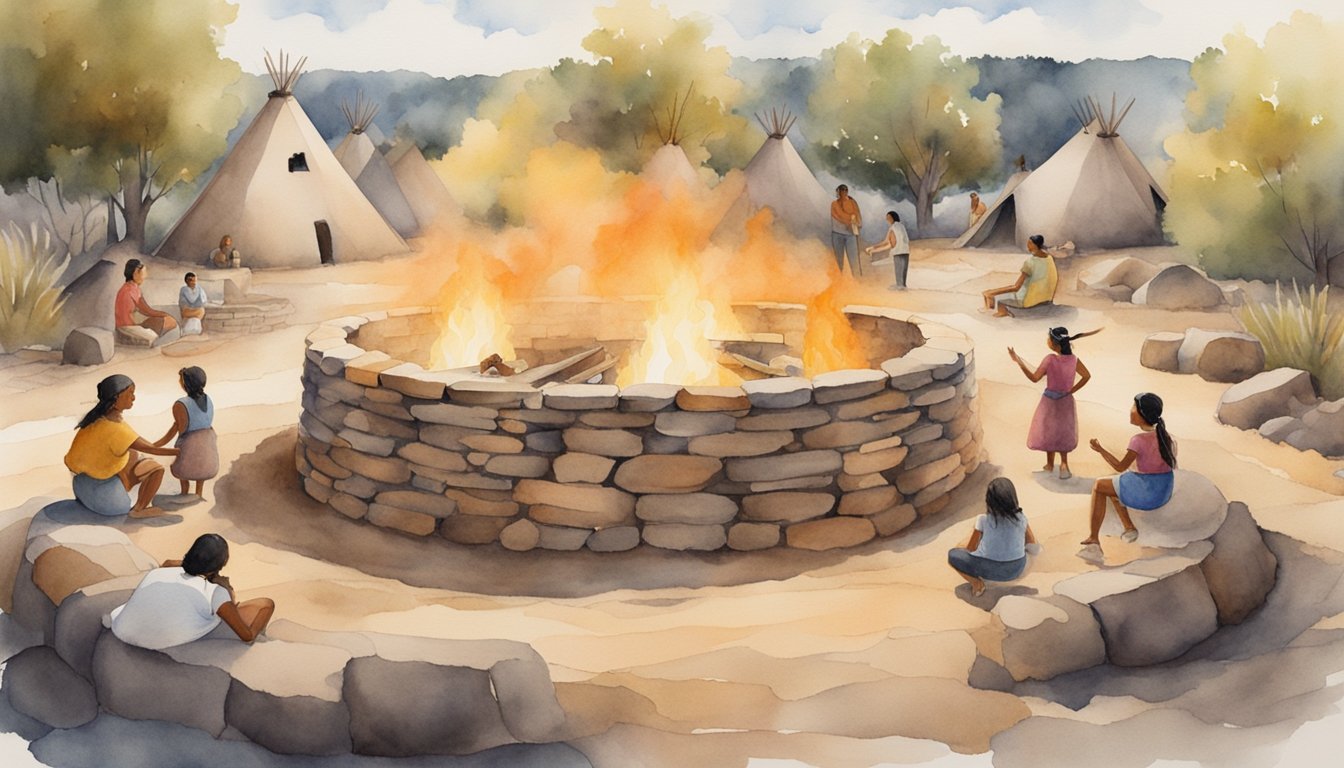Culture and Social Structure

Language and Communication
Aboriginal Australians and Torres Strait Islanders spoke more than 300 languages. However, many of these languages have been lost due to European colonization. Today, some communities speak Australian Aboriginal English or Kriol, a creole language derived from English. Language revitalization programs are working to preserve and revive Indigenous languages.
Traditional Beliefs and Religion
At the heart of Aboriginal culture lies the Dreamtime, containing mythology, lore, and stories that help explain the world and its origins. Key figures in these beliefs include the Rainbow Serpent, Baiame, and Bunjil. These stories and beliefs are often intertwined with the landscape and important cultural practices.
Artistic Expression
Aboriginal art includes rock art and paintings, such as those created by the Papunya Tula artists. Songlines convey stories and connect places through the landscape. The didgeridoo is a well-known musical instrument traditionally used in ceremonial contexts.
Social Organization and Practices
Aboriginal societies have complex social structures based on age and birth. Boys and girls undergo initiation rituals, which vary across the country, into adulthood. Marriage, hunting, and gathering rituals are also important in maintaining cultural practices.
Historical Impact
European colonization had a profound impact on Aboriginal and Torres Strait Islander peoples, leading to the loss of land, culture, and language. The Stolen Generations and massacres have left lasting effects on the communities and their identities.
Modern Identity and Challenges
Today, Aboriginal and Torres Strait Islander peoples often self-identify based on their languages, sacred sites, or objects. They face challenges in maintaining cultural practices, combating discrimination, and addressing intergenerational trauma.
Government and Legislation
The Australian Government provides grants and support for Indigenous community development and cultural preservation. This includes language revitalization programs, protection of sacred sites, and balanced access to education.
Education and Language Revitalization
Efforts are being made to preserve and revive Indigenous languages through educational programs. Children and adults are encouraged to learn these languages in schools and community centers.
Cultural Preservation
Aboriginal and Torres Strait Islander peoples are actively working to preserve their culture by passing on Dreaming stories, maintaining traditional practices, and engaging with modern Australian society.
Interaction with Nature
Historically, Indigenous Australians had a deep connection with nature and relied on hunting and gathering, agriculture, and aquaculture. Today, traditional methods and knowledge are still used in some communities, emphasizing sustainability and stewardship of the land.
Sport and Recreation
Aboriginal and Torres Strait Islander peoples participate in a variety of sports, both traditional and modern. Indigenous athletes have made significant contributions to Australian sports on national and international levels.
Demography and Geography
Population Distribution
Aboriginal peoples, also known as Indigenous Australians, constitute around 3.3% of the country’s total population, with different groups residing mainly in the Northern Territory, Queensland, Western Australia, New South Wales, Victoria, and South Australia. A major part of this population is concentrated in the Northern Territory, where around 30% of the population is Indigenous 1.
Traditional Territories
Historically, Indigenous peoples of Australia occupied a broad range of territories, extending from mainland Australia to the islands of New Guinea and Tasmania. Important areas inhabited by Aboriginal groups include Arnhem Land, a region in the northeastern part of the Northern Territory, Nauwalabila I, and Madjedbebe, both archaeological sites containing evidence of human settlement dating back at least 65,000 years ago 2.
Connection to the Land
Aboriginal communities have a strong connection to the land, as it forms the basis of their Dreaming stories, songlines, and sacred sites. The Dreaming is an important aspect of Indigenous culture and spiritual beliefs, as it explains the creation of the world and the land. Songlines trace the journeys of ancestral spirits across the continent and are often associated with specific landscapes and natural features 3.
Historical Movements
It is believed that the ancestors of the Indigenous peoples of Australia arrived at the continent around 50,000 years ago via the southern route that connected Asia to Australia through a series of watercraft voyages. They used watercrafts to cross the sea between islands, and the people followed the Murray River, one of Australia’s major river systems, to reach the continent’s interior 1.
Genetic Origins and Relations
Evidence from genetic studies suggests that the ancestors of Australian Aboriginal peoples may have originated from Africa before migrating to Southeast Asia. They reached the continental landmasses of New Guinea, Timor, and mainland Australia, where they resided for thousands of years before European contact 2.
Linguistic Diversity
There are hundreds of Aboriginal languages spoken throughout Australia, highlighting the cultural diversity among different Indigenous groups. Some of the prominent Australian Aboriginal languages include Yolngu, Arrernte, Nunga, Koori, and Murri. Many of these languages are now considered endangered, with only a small percentage of Indigenous Australians speaking them 4.
Urban Aboriginal Communities
While a significant proportion of Indigenous peoples continue to reside in remote areas, many Aboriginal groups have also formed communities in urban areas throughout Australia. These communities include the so-called “Black” communities of Western Sydney and other major urban centers. The establishment of urban Indigenous communities presents a landscape of diverse cultural interactions and adaptations as Indigenous Australians continue to negotiate their traditional cultural practices within contemporary Australian society 4.

